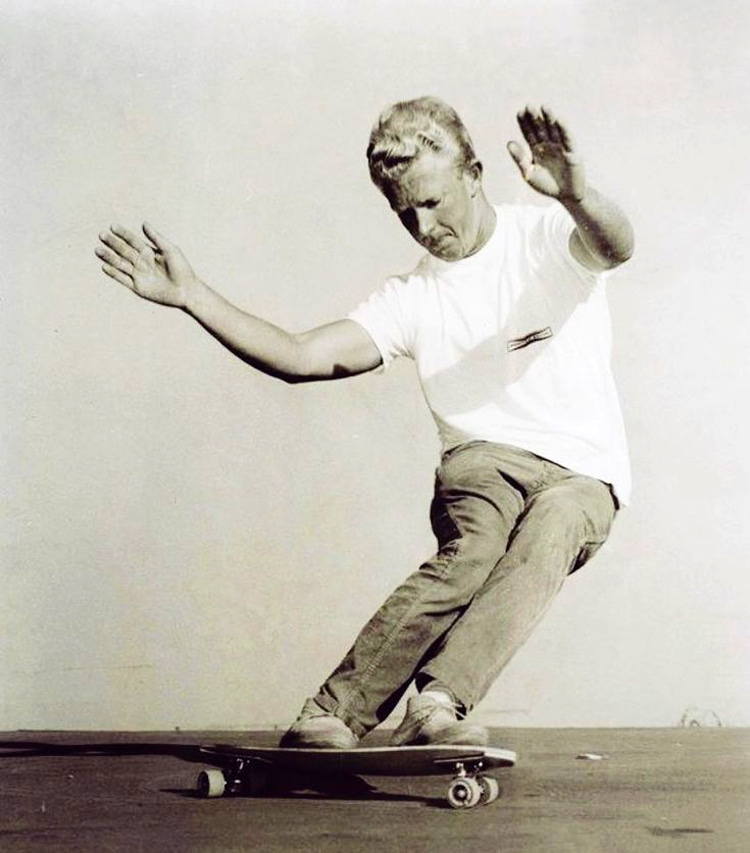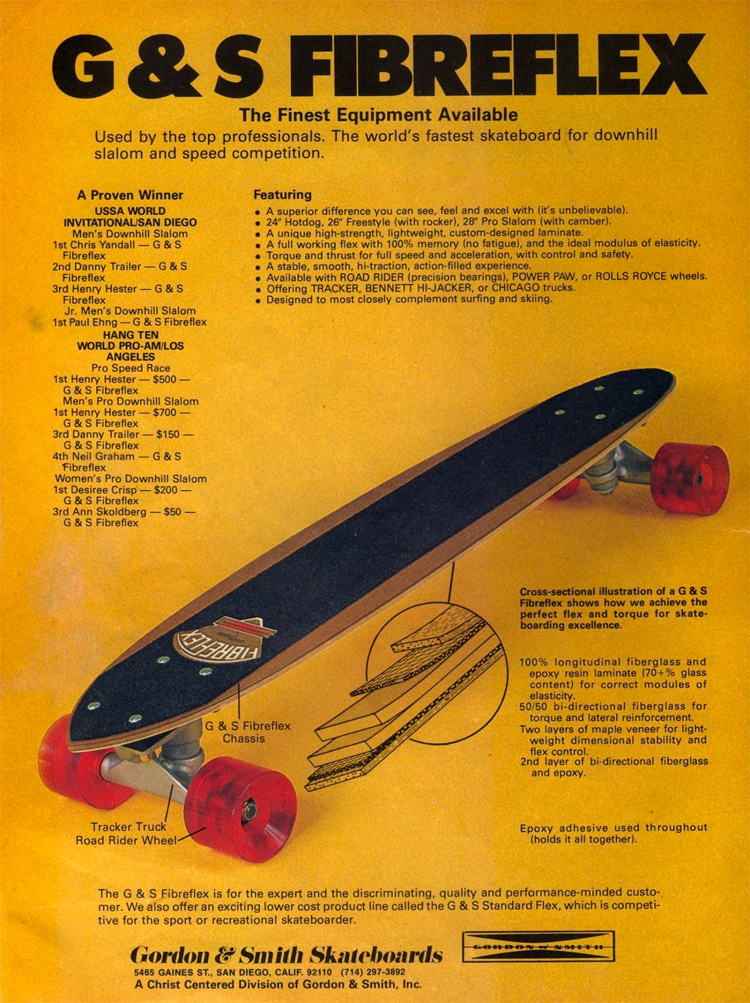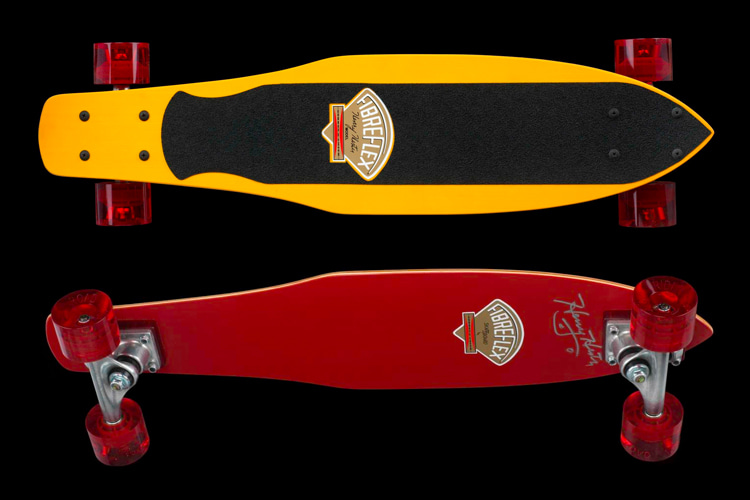Who could have predicted that the sports of archery and skateboarding would one day connect to create one of the most popular skateboards ever produced - the Fibreflex.
The Fibreflex was manufactured by Gordon & Smith. The roots of Gordon & Smith go back to the late 1950s.
Surfer Larry Gordon was studying chemistry in college when he joined up with Floyd Smith.
The two began making surfboards in the corner of the Gordon Plastics factory run by Larry's father and two uncles.
Eventually, Larry and Floyd moved out of Gordon Plastics and into Floyd's garage.
In 1962, Larry left school and went into manufacturing surfboards full-time. The company was known as Gordon & Smith Surfboards.
In the summer of 1964, Larry's cousin Mike returned home from college, where he had been studying business and chemistry.

Archery and Skateboarding
At the time, skateboarding was gaining in popularity, and Larry came up with a brilliant idea.
He took a material called Bo-Tuff and combined it with a wood core to create a skateboard deck.
Bo-Tuff was a fiberglass-reinforced epoxy that was used to make bows for the archery industry. Bo-Tuff had some amazing physical properties.
For example, a bow that incorporated Bo-Tuff set a world record for shooting an arrow - it went over one mile!
By utilizing Bo-Tuff along with a maple wood core, Gordon & Smith developed a skateboard that gave an extremely responsive ride.
The camber - or arc - of the board also added to its responsiveness.
If you pushed down on a Fibreflex, it would spring back into place immediately. It was the first laminated skateboard.
In an interview for SkateBoarder magazine in 1978, Larry Gordon described the skateboard atmosphere in the mid-1960s.
"Slalom racing was the most exciting aspect of the sport at that time, and we felt we had a better idea for a skateboard design," Gordon stated.
Larry teamed up with friend Jim Hovde and formed a company to make Fibreflex skateboards.
They made a few at a time and eventually produced a thousand boards using a hand-screw press.
Over time, a Fibreflex slalom team was put together.
Surfers like Skip Frye, Willie Phillips, John Haywoods, Tommy Ryan, Denis Shufeldt, and Mike Hynson dominated the First Annual Skateboard Contest held in Anaheim in May of 1965.
But most skateboarders in the mid-1960s were content to ride on wooden boards that gave little to no flex.
The highly advanced technology of the Fibreflex was lost on most skaters, who were still trying to deal with the challenges of clay wheels.
When the skateboard craze died in late 1965, so did the production of the Fibreflex. It would take close to ten years before another one was manufactured.

500 Fibreflex Per Day
Larry and Mike decided to resume production in 1974 in a garage with the same equipment that had been used in the 1960s.
On average, Mike was producing about 25 boards a day. Eventually, Mike decided to join his uncle back at Gordon Plastics.
He also moved his Fibreflex equipment from the garage to the factory, where there were more presses.
The introduction of the urethane wheel in the early 1970s brought with it a number of skateboarders who were enthralled by slalom skating.
The speed and the smooth, flowing motion that could be achieved on a Fibreflex made it an extraordinary skateboarding experience.
The skateboard magazines featured numerous ads and articles on slalom pros Paul Engh, Henry Hester, and Chris Yandall (who, of course, were winning contests on Fibreflex skateboards).
By the mid-1970s, the factory was churning out 500 Fibreflex boards a day, which was still not enough to meet the demand.
Dave McIntyre, head of the sales division at that time, vividly recalls having six months' worth of orders!
On the basis of the success they had with the slalom skateboard, Gordon & Smith soon introduced other Fibreflex models.
There was a freestyle model that came with a rocker (the reverse of a camber) and a 25-27-inch kicktail model that proved to be very popular.
In 1977, they released a stiffer model called Bowlrider, which offered the flex of fiberglass and the stability of a wood board.
A Timeless Inspiration
Soon after the introduction of other Fibreflex models, Gordon & Smith came out with a solid wood board, which, according to their ad copy, was made from ash or oak, depending upon what was available.
There were two models - a flat wooden board and the Stacy Peralta Warptail model.
In the course of 18 months, 110,000 Warptail boards were sold.
The Warptail II model, which incorporated layers of maple veneer, was significantly lighter.
Gordon & Smith also marketed the Rockit deck, which is similar in construction to the Warptail II.
In 1978, after their success with both fiberglass and wood models, the company introduced the Teamrider, the widest and largest Fibreflex they had ever made.
It was one of the most versatile boards, and countless photos displayed it being used in both vertical and freestyle riding.
Over time, however, skateboard manufacturers like Gordon & Smith moved away from fiberglass.
Slalom riding took a backseat as more skaters became interested in halfpipes, bowls, wooden ramps and, of course, concrete skateparks.
By 1979, the Fibreflex line was replaced by strictly plywood-type boards, although the Teamrider model was still available.
The G&S Proline, Dennis Martinez's Flying Ace, and Doug Saladino's Pine Design were all vertical boards.
Finding an original Fibreflex board nowadays is difficult.
The ABC Company licensed the Gordon & Smith Skateboards trademark and reissued Fibreflexes, allowing riders to experience the ultimate cruising and carving experience once more.
However, in 1998, Larry Gordon decided to begin production of a longboard Fibreflex that is an incredibly responsive ride, making Fibreflex one of the most enduring names in skateboarding.
Words by Michael Brooke | Skateboarder and Author of "The Concrete Wave: The History of Skateboarding"
